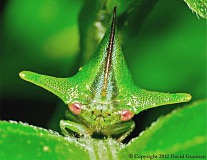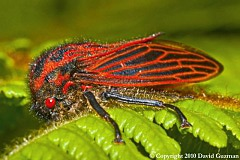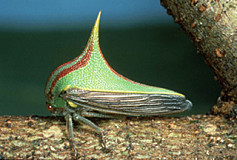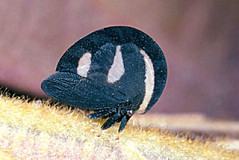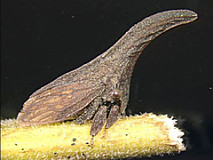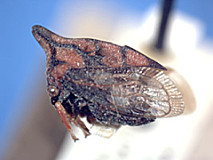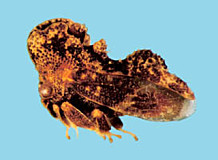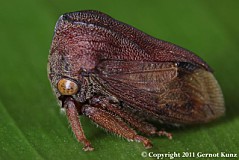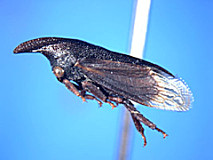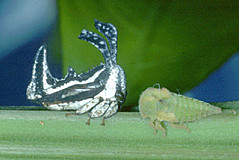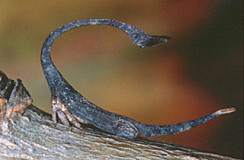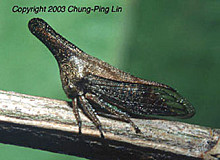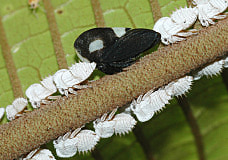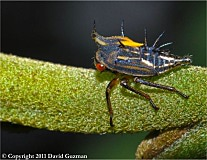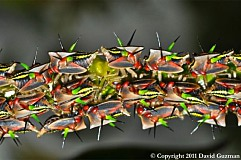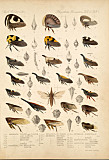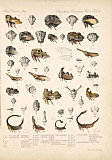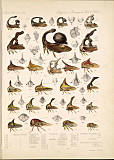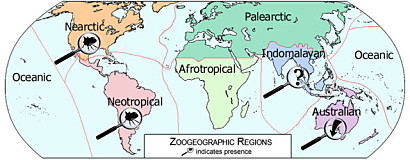Rafinesque 1815a
Funkhouser 1927f
Funkhouser 1951a
Metcalf and Wade 1965a
Deitz 1975a
Dietrich and McKamey 1995a
McKamey 1998a
Lin, Danforth, and Wood 2004a
Godoy, Miranda, and Nishida 2006a
Wallace 2010a
McKamey 2022a
Flórez-V. 2022a
Animalia → Arthropoda → Insecta → Pterygota → Hemiptera → Auchenorrhyncha → Cicadomorpha → Membracoidea → Membracidae
Membracinae Rafinesque, 1815
Synonyms (and unplaced invalid names)
Hoplophorioninae Goding, 1926, Tectiscuti Amyot and Serville, 1843
Selected references
Overview
Phylogenetic analyses based on morphological (Dietrich and McKamey 1995a) and molecular data (Lin, Danforth, and Wood 2004a) indicate the subfamily Membracinae is in serious need of reclassification at both the generic and tribal levels. The tribes Aconophorini, Hoplophorionini, and Hypsoprorini all appear to be monophyletic groups, each with distinct morphologies and behaviors, however, the taxonomic limits and phylogenetic status of the “Membracini,” “Bolbonotini” (here considered a synonym of Membracini), and “Talipedini” remain unclear. The taxonomic limits of many of the included genera must be clarified as a precursor to redefining the tribes and elucidating the relationships among them (Dietrich and McKamey 1995a). Flórez-V. (2022a) prepared a revised key to the five currently recognized tribes and the genus Oropedium, which is currently incertae sedis within Membracinae.
Taxon images
Distribution
Neotropical and Nearctic regions: throughout most of the temperate and tropical regions of the Americas, including the West Indies; questionably introduced to Indomalayan region; introduced to Australian region.
Diagnostic characters
Pronotum simple, globular, or foliaceous, with or without frontal, dorsal, lateral, or posterior horns or tubercles; posterior process entirely concealing scutellum. Forewings in repose fully exposed; claval apex truncate (most taxa) or acuminate (Hysoprorini); apical limbus broad, at least in part. Pro- and mesothoracic tibiae simple to extremely foliaceous. Metathoracic tibiae simple, foliaceous, or distally clavate, tibial rows I and II often with prominently cucullate setae, row III with weakly cucullate setae (most Aconophorini) or absent, all tibial rows absent in most Hoplophorionini (some with setae in row I). Abdomen with or without conspicuous pits.
Taxonomic constituents
Aconophorini Goding, 1892 Goding, 1892
Hoplophorionini Goding, 1926 Goding, 1926
Hypsoprorini Haupt, 1929 Haupt, 1929
Membracini Rafinesque, 1815 Rafinesque, 1815
Oropedium Flórez-V., 2022 Flórez-V., 2022
Talipedini Deitz, 1975 Deitz, 1975
Prepared by
Lewis L. Deitz, Olivia Evangelista, Matthew S. Wallace, and Mark J. Rothschild, 21 September 2022.


